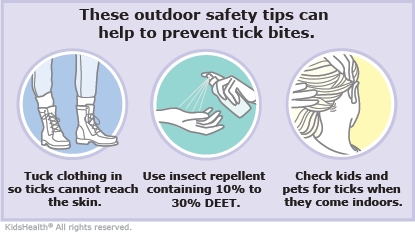Rocky Mountain Spotted Fever: How to Care for Your Child
Rocky Mountain spotted fever (RMSF) usually can be treated successfully with antibiotics. But with late or no treatment, RMSF can cause serious health problems.


RMSF is an illness caused by bacteria called Rickettsia rickettsii. It is spread to humans through tick bites. Usually, a tick must be attached to a person's skin for several hours in order to give someone RMSF.
Signs of RMSF usually begin within 2 days to 2 weeks of a tick bite. Often, a key sign is a rash that begins on the wrists, forearms, and ankles, and sometimes on the palms and soles. Other signs may include fever, chills, muscle aches, vomiting, red eyes, headache, belly pain, and nausea.
If RMSF is not treated, the infection can get worse. It can cause problems in the brain, heart, lungs, nerves, and other parts of the body.
The health care provider asked you and your child questions and did a careful examination. Based on this information, the health care provider believes that your child likely has RMSF and will begin treatment for this infection. Blood tests, and possibly skin tests, have been done to help make the diagnosis. Future blood tests also may be needed to confirm it.
Antibiotics usually work well to treat RMSF. Your health care provider feels your child can take antibiotics by mouth and can be safely cared for at home.

-
Have your child complete the entire course of antibiotics prescribed to completely treat the infection, even if your child is feeling better.
-
Let your child rest as much as needed.
-
If your child is uncomfortable, a medication may help:
-
For children under 6 months, you may give acetaminophen.
-
For children over 6 months, you may give acetaminophen OR ibuprofen, if recommended by your health care provider.
-
If your child has an upset stomach, offer frequent, small meals.
-
Encourage your child to drink plenty of liquids.


Your child:
-
Still has a fever after 3 days of being on antibiotics.
-
Has trouble hearing.
-
Is vomiting and not keeping down fluids.
-
Develops any other new symptoms.

Your child:
-
Has severe belly pain.
-
Has trouble speaking, walking, or moving any body parts.
-
Has tingling, weakness, numbness, or a change of color in the hands, feet, or other parts of the body.
-
Develops eye pain or changes in vision.
-
Seems very confused or disoriented.
-
Has trouble breathing or starts breathing very fast.
-
Has a bad headache or a stiff neck, or is bothered by light.
-
Appears to be dehydrated; signs include dizziness, drowsiness, a dry or sticky mouth, sunken eyes, producing less urine or darker urine than usual, and crying with few or no tears.

These outdoor safety tips can protect your whole family from future tick bites:
-
Don't sit on the ground in wooded areas.
-
Use insect repellent containing 10% to 30% DEET on children and adults. Ask your health care provider about insect repellents for infants and toddlers.
-
Dress in closed shoes, long sleeves, and pants when in wooded or grassy areas. Tuck the shirt into pants and the pant legs into socks to keep ticks out.
-
Wear light-colored clothing so you can see ticks more easily.
-
Check children, as well as dogs and cats, for ticks when they come indoors.